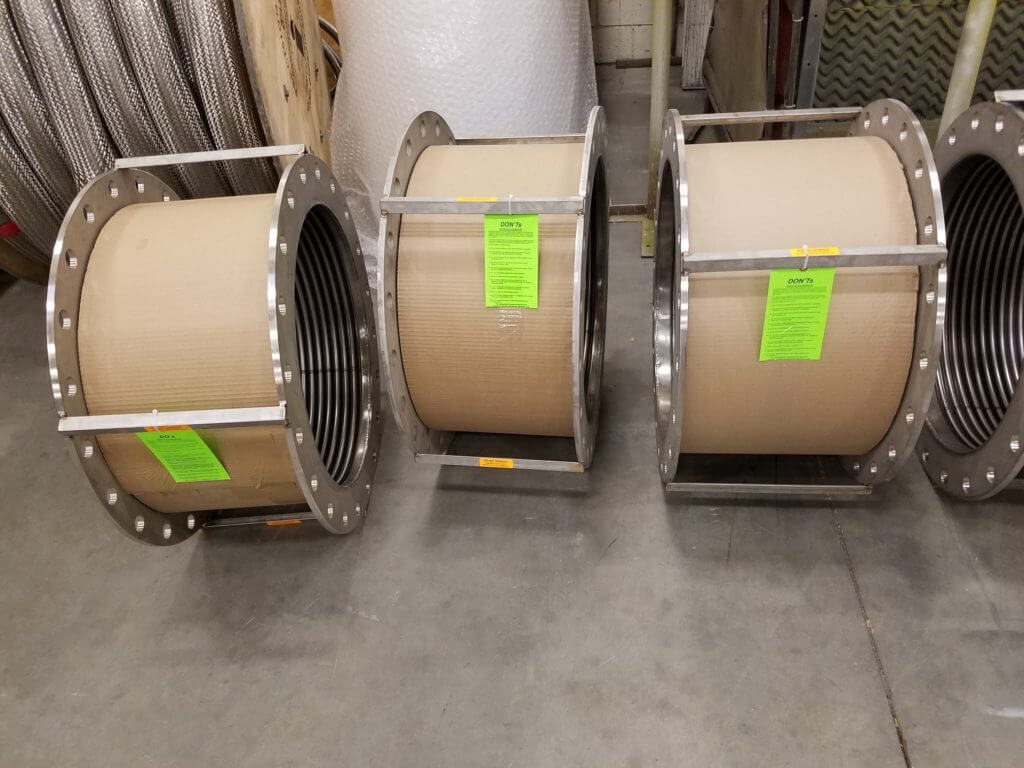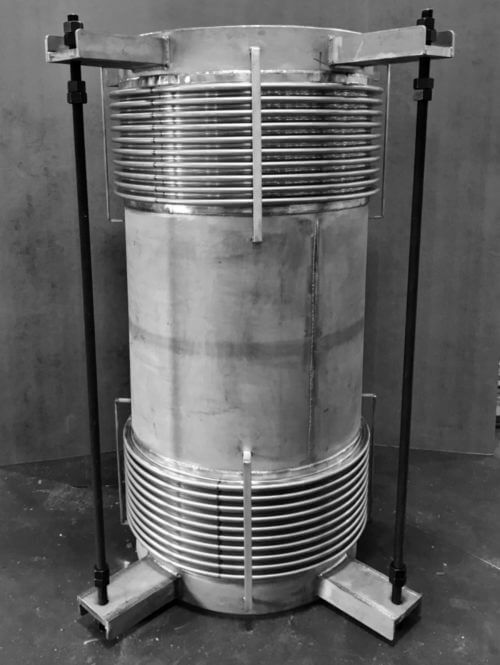Precision Hose & Expansion Joints designs, manufactures, and supplies expansion joints in accordance with EJMA (Expansion Joint Manufacturers Association) Standards. The EJMA Standards are recognized throughout the world as the premier authority on the proper selection and application of metal expansion joints for safe and reliable piping and vessel installations. The following DO’s and DON’Ts are to be used as a guide for how to properly handle expansion joints before, during, and after installation. Failure to follow this guide can result in a premature failure of the expansion joint. For any questions, or for a more detailed explanation of any of the below, please contact Precision Hose & Expansion Joints.
Metal Bellows Expansion Joints have been designed to absorb a specified amount of movement by flexing of the thin-gauge convolutions. If proper care is not taken during installation, it may reduce the cycle life and the pressure capacity of the expansion joints, which would result in an early failure of the bellows element or damage the piping system. The following recommendations are included to avoid the most common errors that occur during installation. When in doubt about an installation procedure, contact the manufacturer for clarification before attempting to install the Expansion Joint.
A copy of these DO’s and DON’Ts for metal expansion joints are provided with each of our products that leave our facility. If you receive an expansion joint to your shop or job site and it does not have a copy of this document, please immediately contact Precision Hose & Expansion Joints at 770-413-5680.
DO’s for Metal Expansion Joints
STANDARDS OF THE EXPANSION JOINT MANUFACTURERS ASSOCIATION, INC.
- Inspect for damage during shipment, i.e., dents, broken hardware, watermarks on cartons, etc.
- Store in a clean dry area where it will not be exposed to heavy traffic or damaging environment.
- Use only designated lifting lugs.
- Make the piping systems fit the expansion joint. By stretching, compressing, or offsetting the joint to fit the piping, it may be overstressed when the system is in service.
- It is good practice to leave one flange loose until the expansion joint has been lifted into position. Make necessary adjustment of loose flange before welding.
- Install joint with an arrow pointing in the direction of flow. (If Applicable)
- Install single Van Stone liners pointing in the direction of flow. Be sure to install a gasket between the liner and Van Stone flange as well as between the mating flange and liner. With telescoping Van Stone liners, install the smallest I.D. liner pointing in the direction of the flow.
- Remove all shipping devices after installation is complete and before any pressure test of the fully installed system.
- Remove any foreign material that may have become lodged between the convolutions.
- Refer to EJMA Standards for proper guide spacing and anchor recommendations.
The manufacturer’s warranty may be void if improper installation procedures have been used.
DON’Ts for Metal Expansion Joints
STANDARDS OF THE EXPANSION JOINT MANUFACTURERS ASSOCIATION, INC.
- Do not drop or strike carton.
- Do not remove shipping bars until installation is complete.
- Do not remove any moisture-absorbing desiccant bags or protection coatings until ready for installation.
- Do not use hanger lugs as lifting lugs without approval from the manufacturer.
- Do not use chains or any lifting device directly on the bellows or bellows cover.
- Do not allow weld splatter to hit unprotected bellows. Protect with wet chloride-free insulation.
- Do not use cleaning agents that contain chlorides.
- Do not use steel wool or wire brushes on bellows.
- Do not force-rotate one end of an expansion joint for alignment of bolt holes. Ordinary bellows are not capable of absorbing torque.
- Do not hydrostatic pressure test or evaluate the system before installation of all guides and anchors.
- Pipe hangers are not adequate guides.
- Do not exceed a pressure test of 1-1/2 times the rated working pressure of the expansion joint.
- Do not use shipping bars to retain thrust if tested prior to installation.
The manufacturer’s warranty may be void if improper installation procedures have been used.
[DISPLAY_ACURAX_ICONS]



72 Comments
buy viagra 25mg
canadian drugs https://hkwerf.micro.blog/
With thanks. I value it.
my.desktopnexus.comCanadian-pharmaciesjournalsafe-canadian-online-pharmacies-38571
cialis pills https://my.desktopnexus.com/Canadian-pharmacies/journal/safe-canadian-online-pharmacies-38571/
Thanks, I appreciate it!
canadian pharmacies without an rx
canada pharmacies online https://canadian-government-approved-pharmacies.webflow.io/
You actually reported that superbly!
lasevs.estranky.czclankypharmaceuticals-online-australia.html
cialis tablets https://lasevs.estranky.cz/clanky/pharmaceuticals-online-australia.html
Thanks! I like it!
https://kawerc.proweb.cz/
cialis lowest price https://kawerc.proweb.cz/
Thanks a lot. Quite a lot of tips!
canadian pharmacy viagra brand
no 1 canadian pharcharmy online https://pedrew.zombeek.cz/
With thanks! I like this.
https://fermser.flazio.com/
cialis prices https://fermser.flazio.com/
Tips well used..
pharmacy canada
pharmacy canada https://londondrugscanada.bigcartel.com/london-drugs
Amazing a good deal of valuable info.
canada pharmacy online
cialis from canada https://canadapharmacy.teachable.com/
Nicely put, Thanks a lot.
https://fofenp.wixsite.com/london-drugs-canada/en/post/pharmacies-shipping-to-usa-that/
tadalafil 5mg https://fofenp.wixsite.com/london-drugs-canada/en/post/pharmacies-shipping-to-usa-that/
Incredible a good deal of fantastic knowledge!
https://swebas.livejournal.com/359.html
tadalafil 20mg https://swebas.livejournal.com/359.html
You said this perfectly!
canadian pharmacy online 24
canadian pharmacy uk delivery https://lawert.micro.blog/
You said this really well.
canadian pharcharmy online
canadian pharmacy viagra brand https://canadian-pharmacies.webflow.io/
With thanks, Numerous advice.
https://my.desktopnexus.com/kawemn/journal/pharmaceuticals-online-australia-38678/
online prescriptions without a doctor https://my.desktopnexus.com/kawemn/journal/pharmaceuticals-online-australia-38678/
Wow many of good tips!
https://www.divephotoguide.com/user/drugs
Cheap cialis https://www.divephotoguide.com/user/drugs
Regards, A lot of info!
canadian pharmacies online
canadian pharmacy meds https://hub.docker.com/r/dkwer/drugs
Kudos! Very good stuff!
canada pharmacies
buy viagra online usa https://form.jotform.com/decote/canadian-pharmacies-shipping-to-the
You actually revealed that effectively.
https://linktr.ee/canadianpharmacy
cialis https://linktr.ee/canadianpharmacy
Wonderful advice. Appreciate it.
https://kawers.micro.blog/
tadalafil tablets https://kawers.micro.blog/
Tips nicely applied.!
mewser.mystrikingly.com
tadalafil 20 mg https://mewser.mystrikingly.com/
Effectively voiced truly! .
sbwerd.estranky.skclankycialis-generic-pharmacy-online.html
online prescriptions without a doctor https://sbwerd.estranky.sk/clanky/cialis-generic-pharmacy-online.html
Cheers. Helpful information!
alewrt.flazio.com
buy cialis without a doctor’s prescription https://alewrt.flazio.com/
Whoa a lot of useful tips.
https://buycialisonline.fo.team/
tadalafil https://buycialisonline.fo.team/
This is nicely expressed! .
buy cials online
cialis tablets australia https://laswert.wordpress.com/
You said it adequately.!
https://kasheras.livejournal.com/283.html
buy cialis https://kasheras.livejournal.com/283.html
Fantastic forum posts. Regards.
buy cheap cialis coupon
cialis lowest price https://kwxcva.estranky.cz/clanky/cialis-20-mg.html
Kudos, I like it!
https://tadalafil20mg.proweb.cz/
generic cialis https://tadalafil20mg.proweb.cz/
Position effectively applied!!
buy cials online
cialis generico online https://owzpkg.zombeek.cz/
Regards! An abundance of forum posts!
https://lasweb.iwopop.com/
cialis uk https://lasweb.iwopop.com/
You have made your point very effectively!.
https://buycialisonline.bigcartel.com/cialis-without-a-doctor-prescription
tadalafil generic https://buycialisonline.bigcartel.com/cialis-without-a-doctor-prescription
Thanks. I like this.
buycialisonline.teachable.com
Cialis tadalafil https://buycialisonline.teachable.com/
You mentioned this fantastically!
https://kalwer.micro.blog/
cialis purchase online without prescription https://kalwer.micro.blog/
You actually mentioned it terrifically.
buy generic cialis online
cialis 5mg https://my.desktopnexus.com/Buycialis/journal/cialis-without-a-doctor-prescription-38780/
Excellent info. Appreciate it!
www.divephotoguide.comuserbuycialisonline
cialis 5mg prix https://www.divephotoguide.com/user/buycialisonline
Thank you. An abundance of posts!
buy cialis cheap
tadalafil 10 mg https://hub.docker.com/r/tadalafil/20mg
This is nicely expressed. .
buy cialis
buy cialis without a doctor’s prescription https://tadalafil20mg.webflow.io/
Thanks, Plenty of knowledge!
https://kswbnh.nethouse.ru/
cialis prices https://kswbnh.nethouse.ru/
Nicely voiced indeed! !
buy cialis online without a prescription
tadalafil 10 mg https://www.formlets.com/forms/fpN4Ll8AEnDHBAkr/
Really loads of helpful material!
buy tadalafil online
tadalafil tablets https://form.jotform.com/ogmyn/buycialisonline
With thanks, Plenty of data!
linktr.eebuycialisonline
tadalafil https://linktr.ee/buycialisonline
Useful data. Kudos!
https://telegra.ph/Cialis-20mg-08-13
buy generic cialis https://telegra.ph/Cialis-20mg-08-13
Very good postings. Appreciate it.
buy cialis online best price
cialis tablets https://graph.org/Tadalafil-20mg-08-13
Truly tons of valuable material.
kwenzx.nethouse.ru
tadalafil https://kwenzx.nethouse.ru/
You suggested that very well!
Canadian Pharmacy USA
canada pharmacies https://dwerks.nethouse.ru/
Amazing a lot of valuable data.
form.jotform.comycaatkcanadian-pharmaceuticals-online-lis
buy cialis https://form.jotform.com/ycaatk/canadian-pharmaceuticals-online-lis
Thanks a lot, Good information!
online canadian pharmacies
canadian pharmacies mail order https://linktr.ee/onlinepharmacies
Nicely put, Thanks!
https://telegra.ph/Reputable-canadian-pharmaceuticals-online-08-12
purchasing cialis on the internet https://telegra.ph/Reputable-canadian-pharmaceuticals-online-08-12
Nicely put. Many thanks.
graph.orgPharmacies-in-canada-shipping-to-usa-08-12
cialis 20mg prix en pharmacie https://graph.org/Pharmacies-in-canada-shipping-to-usa-08-12
Truly a good deal of good facts!
https://telegra.ph/Recommended-canadian-pharmacies-08-12
buy cialis https://telegra.ph/Recommended-canadian-pharmacies-08-12
You explained that perfectly.
https://graph.org/Safe-canadian-online-pharmacies-08-12
Cheap cialis https://graph.org/Safe-canadian-online-pharmacies-08-12
Thanks, Plenty of content!
https://linktr.ee/canadianpharmacies
medication without a doctors prescription https://linktr.ee/canadianpharmacies
You said it very well.!
buyviagraonlinee.mystrikingly.com
buy cialis https://buyviagraonlinee.mystrikingly.com/
Nicely put, Thank you.
buyviagraonline.estranky.skclankybuy-viagra-without-prescription-pharmacy-online.html
canadian cialis https://buyviagraonline.estranky.sk/clanky/buy-viagra-without-prescription-pharmacy-online.html
Regards. Lots of postings.
buyviagraonline.flazio.com
cialis purchase online without prescription https://buyviagraonline.flazio.com/
Good facts. Thank you!
buyviagraonline.fo.team
cialis prices https://buyviagraonline.fo.team/
Good knowledge. Appreciate it!
buy viagra online
Generic viagra https://noyano.wixsite.com/buyviagraonline
Thank you, I appreciate it.
buyviagraonlinet.wordpress.com
medication without a doctors prescription https://buyviagraonlinet.wordpress.com/
Cheers! An abundance of data!
buyviagraonl.livejournal.com386.html
buy cialis without a doctor’s prescription https://buyviagraonl.livejournal.com/386.html
Regards! Good information!
buyviagraonline.nethouse.ru
cialis online https://buyviagraonline.nethouse.ru/
Kudos, An abundance of material!
buyviagraonline.estranky.czclankycan-i-buy-viagra-without-prescription.html
cialis https://buyviagraonline.estranky.cz/clanky/can-i-buy-viagra-without-prescription.html
Nicely put. Thanks.
https://buyviagraonline.proweb.cz/
cialis online https://buyviagraonline.proweb.cz/
With thanks, Ample posts.
buyviagraonline.zombeek.cz
cialis without a doctor’s prescription https://buyviagraonline.zombeek.cz/
Nicely put, Thanks a lot!
https://jso7c59f304.iwopop.com/
Cheap cialis https://jso7c59f304.iwopop.com/
Seriously quite a lot of useful facts!
buy viagra usa
Viagra vs viagra https://buyviagraonline.bigcartel.com/viagra-without-a-doctor-prescription
Reliable advice. Thank you.
https://buyviagraonline.teachable.com/
cialis from canada https://buyviagraonline.teachable.com/
You explained it very well.
https://telegra.ph/How-to-get-viagra-without-a-doctor-08-18
Cialis tadalafil https://telegra.ph/How-to-get-viagra-without-a-doctor-08-18
Cheers. Plenty of information!
graph.orgBuying-viagra-without-a-prescription-08-18
cialis canada https://graph.org/Buying-viagra-without-a-prescription-08-18
This is nicely put. .
https://buyviagraonline.micro.blog/
tadalafil 10 mg https://buyviagraonline.micro.blog/
You actually expressed it wonderfully.
buy viagra with no prescription
Viagra 5mg prix https://my.desktopnexus.com/buyviagraonline/journal/online-viagra-without-a-prescriptuon-38932/
You stated that very well.
www.divephotoguide.comuserbuyviagraonline
cialis from canada https://www.divephotoguide.com/user/buyviagraonline
Thank you. I enjoy this.
https://hub.docker.com/r/buyviagraonline/viagra
cialis 5mg https://hub.docker.com/r/buyviagraonline/viagra
Regards! Loads of postings.
viagrawithoutprescription.webflow.io
cialis tablets australia https://viagrawithoutprescription.webflow.io/
Thanks a lot, Quite a lot of info.